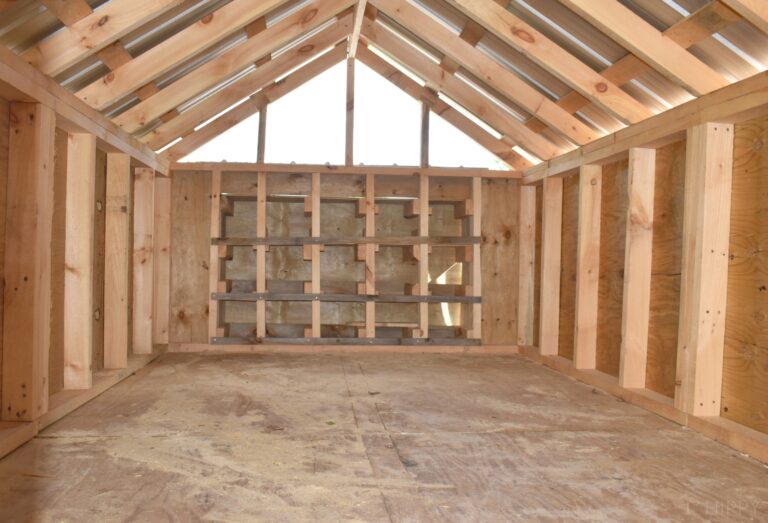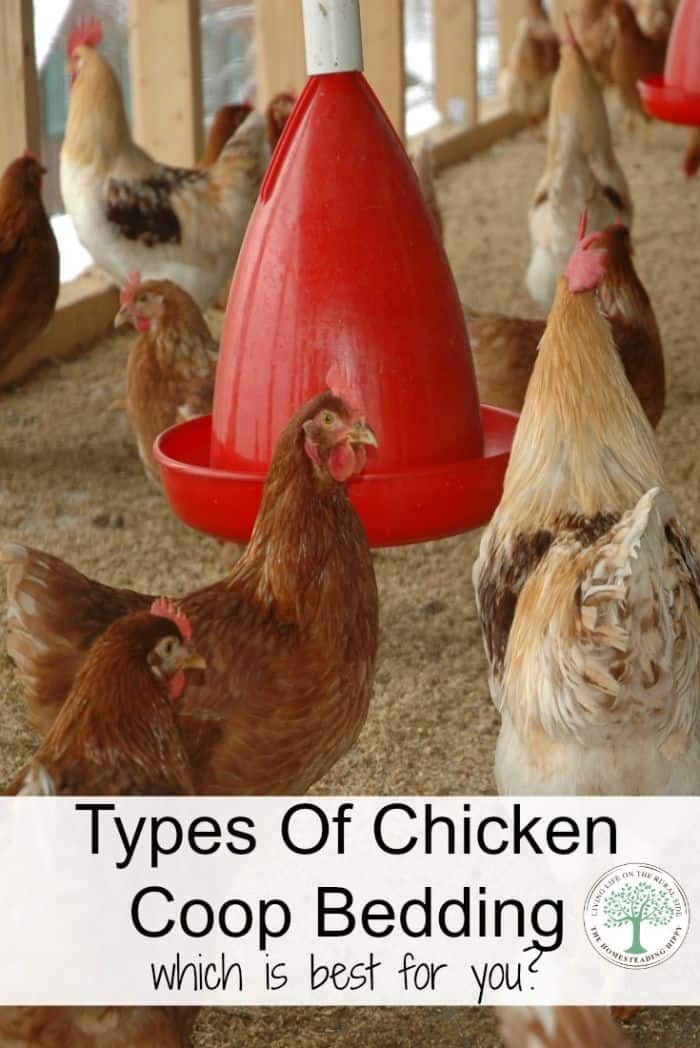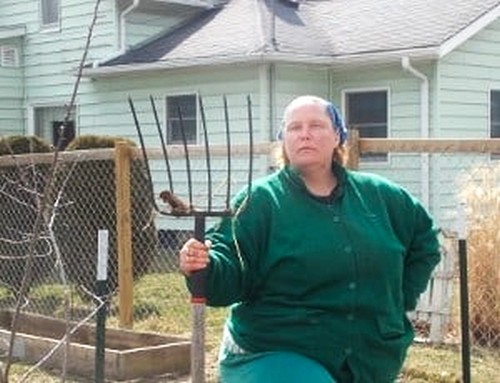All chicken owners will need to think about chicken coop bedding. Especially if they are in a stationary coop.
Adding bedding makes manure removal easier, keeps the coop clean, and can help keep the coop warmer in winter. The type of chicken coop bedding material to use is up to you.

If you have a wooden or concrete chicken coop floor, you will want some type of chicken coop floor material. This will help keep manure easier to clean and a healthier flock.
If you don’t have a concrete or wood floor, a dirt floor chicken coop isn’t a bad way to go. It just may mean a bit more shoveling to remove manure build up.
Here are chicken coop flooring ideas to consider…
How to Choose the Right Chicken Bedding – Qualities to Consider
Chicken bedding is an important part of chicken husbandry. Not only does it provide a comfortable place for your chickens to rest, but it also helps to absorb moisture and keep the coop clean.
There are many different types of chicken bedding available on the market, so how do you choose the right one for your needs? Here are a few qualities to consider:
- Absorbency: Chicken bedding should be able to absorb moisture quickly, preventing damp conditions in the coop.
- Odor control: A good chicken bedding will help to control odors, keeping the coop fresh and clean.
- Dust control: Dust can be harmful to chickens, so look for a chicken bedding that minimizes dust levels.
- Cost: Chicken bedding can vary widely in price, so choose a product that fits your budget.
From these considerations, you can narrow down your choices and select the chicken bedding that is right for your flock.
Bedding Ideas – The List
Sand
Very popular to use and often easy to obtain, sand can be purchased from your local quarry or hardware store.
It is a great chicken coop bedding option because it can also act as grit for the chickens. It is as easy to clean as a litter box and it is cheap.
Sand also does not need to be completely removed from the coop. You can just add more as you need.
It also prevents dust from being stirred up in the coop. If your coop houses 30 or more chickens, expect more work to maintain a clean space.
Deep Litter With Straw
Even more budget-friendly than sand, straw may be a better chicken coop bedding option.
However, this will depend on the size of your coop. It is easy to lay down, less heavy than bags of sand, and can be moved into garden beds or the compost pile when it is changed out.
The chickens will love scratching through the straw and will even help you spread it around. Simply drop a couple bales of straw, remove the strings, and let the girls do the work.
Of course, soiled straw will need to be removed at least monthly and replaced with clean straw.
Since the poop can easily pile up on the straw, it gets matted down and is very heavy to move. In the winter, straw can also collect drips of water and freeze, making it a slushy, slippery mess.
Straw is also great to line nest boxes with, as it gives the chickens a nice, soft place to lay their eggs. Keeping the nest boxes clean with straw will also decrease the need to worry about cleaning your eggs.
Dried Leaves
This is my personal favorite. We collect the leaves from our neighbors and place them in the chicken coop. This prevents the toxins from being released into the air when burned as well. win-win.
The chickens love to play in the leaves, scratching and checking for any bugs or worms that may have made their home in the piles.
Adding at least 12 inches deep of leaves in fall and spring also gives us great compost for the garden.
Removing the leaves and cleaning the chicken coop with this method takes about 20 minutes. Leaves collect the poop and are easy to shovel up.
Another bonus is that leaves will cost you nothing. Just offer your free leaf removal services to your neighbors and enjoy their generosity!
To see how to make your own dust bath area for your chickens, read the post here.
Pine Shavings
This is the most expensive way to bed a coop in my opinion.
Unless you have a huge wood pile and your own chipper. Wood shavings ARE easy to clean up and have a nice, sweet smell when you first lay them down.
Rustic(y) and all, ya know? They are not slippery and slushy in the winter or during a heavy rain, but a con is that they create the most dust out of all the methods we use.
We only use wood chips for our chicks in the spring, as it is easy to clean up from a small brooder.
Wood shavings also work great for chicks, as it gives them a comfortable floor to walk on and exercise their legs with.
Grass Clippings
Grass clippings can be a great choice for chicken bedding as they are absorbent and provide good insulation.
This is a super cheap way to get bedding for your coop on a regular basis. Every time you mow your lawn, simply toss the grass clippings into the bottom of the coop.
One drawback of this method is that you need to replace it every couple of days, and scooping out the manure can be a time-consuming task.
Another drawback is actually a safety concern… If the grass is treated with herbicides or pesticides, it can be harmful to your chickens. In addition, grass clippings can attract vermin such as rats and mice.
Hemp
Hemp has been used as a bedding material for chickens for centuries. More recently, it has seen a resurgence in popularity due to its many benefits.
Hemp is absorbent, dust-free, and naturally resistant to mold and mildew. It also breaks down quickly, making it an excellent choice for composting.
In addition, hemp is relatively inexpensive and easy to find. However, there are some drawbacks to using hemp as chicken bedding.
One downside is that it can be difficult to clean out of the coop. Another issue is that it tends to mat down when wet, which can create an unpleasant environment for the birds.
Overall, hemp is a good bedding material for chickens, but it’s important to weigh the pros and cons before making a decision.
Sawdust
Sawdust has long been a popular choice for chicken bedding, and there are a few good reasons for this.
For one thing, sawdust is absorbent, so it helps to keep the coop clean and dry. In addition, sawdust is relatively inexpensive and easy to find.
However, there are a few potential drawbacks to using sawdust as chicken bedding. First of all, it can be dusty, which can irritate your chickens’ respiratory system. In addition, some types of sawdust (such as cedar) can be harmful if inhaled.
If you decide to use sawdust as chicken bedding, be sure to get it from a reputable source and take steps to reduce the dust in your coop.
Excelsior Fiber
Excelsior fiber, also known as wood wool, is a natural product made from shredded wood. It has a number of advantages as chicken bedding, including its absorbency, ability to control odors, and lack of dust.
Excelsior fiber is also relatively inexpensive and easy to find.
However, there are some disadvantages to using excelsior fiber as chicken bedding. One is that it can be difficult to clean out of the coop. Another is that it can harbor pests, such as mites and fleas.
If you decide to use excelsior fiber as chicken bedding, be sure to clean the coop regularly and inspect for pests.
Shredded Cardboard
Shredded cardboard can make an excellent bedding material for chickens. It is absorbent, inexpensive, and easy to obtain.
However, there are also some potential drawbacks to using shredded cardboard as chicken bedding. One concern is that it might harbor harmful bacteria or pests. Another is that it may not provide enough warmth for chickens in cold weather.
Rocks
Some chicken owners use rocks as bedding for their chickens. There are pros and cons to using rocks as chicken bedding.
One pro is that rocks can help absorb chicken waste and keep the coop cleaner. Another pro is that rocks can help provide insulation for the chickens in colder weather.
A con of using rocks as chicken bedding is that the chickens may ingest the rocks, which can cause health problems. You can get around this concern by using smaller pebbles, which chickens often ingest anyway (aka grit).
Another con is that rocks can become sharp if they are not smoothed down, and this can injure the chickens’ feet.
If you’re concerned about bumblefoot, particularly if you are raising young chickens, you’ll want to keep this in mind.
Hay
Hay is a popular choice for chicken bedding because it is absorbent and relatively inexpensive. However, there are some downsides to using hay as bedding for chickens.
One issue is that hay can harbor mold spores, which can lead to respiratory problems in chickens.
Hay is not quite as absorbent as other bedding materials, so it will need to be changed more often, but on the plus side, it tends to be less expensive and more readily available than other kinds of bedding, like straw.
In addition, hay tends to break down quickly, so it needs to be replaced more often than other types of bedding.
Newspaper
Using newspaper as chicken bedding has a number of pros and cons. On the plus side, newspaper is extremely absorbent, so it can help to keep the coop clean and dry. In addition, newspapers are very cheap and easy to obtain.
On the downside, newspaper can be difficult to dispose of, and it does not provide any insulation for chickens in cold weather. In addition, some chickens may peck at the ink on the paper, which can be harmful.
What Kind of Bedding Should I Use in Nesting Boxes?
There are a few different options when it comes to bedding for nesting boxes. Some common choices include pine shavings, straw, or shredded paper. Each of these materials has its own pros and cons.
Pine shavings are absorbent and help to keep the nest clean and dry. However, they can also be relatively expensive. Straw is another popular choice, as it is readily available and relatively inexpensive.
However, it does not absorb moisture as well as pine shavings, and can also harbor mold spores. Shredded paper is a third option that is often used in nesting boxes. It is absorbent, relatively inexpensive, and easy to find.
However, it may not provide as much cushioning as straw or pine shavings.
Ultimately, the best bedding for your nesting boxes will depend on your own preferences and budget.
What is the Best Brooder Bedding?
When it comes to brooder bedding, there are a variety of options available. However, not all bedding materials are created equal. Some common choices, such as straw or hay, can harbor harmful bacteria and parasites.
Other materials, such as sand or wood shavings, can be difficult to keep clean and comfortable for your chicks, particularly if you’re on a budget. That said, they tend to be some of the most absorbent.
So, what is the best bedding for a brooder? One option that strikes a balance between safety and comfort – and that many chicken keepers are unaware of – is peat moss.
Peat moss is naturally antimicrobial, so it helps to prevent the spread of disease. In addition, peat moss is absorbent and soft, making it a cozy choice for your chicks.
While there are other options available, peat moss is an ideal choice for those looking for a safe and comfortable brooder bedding material.
What Kind of Bedding You Shouldn’t Use in a Chicken Coop?
There are a few types of bedding that you should avoid using in your chicken coop. First, stay away from any type of treated wood, such as pressure-treated lumber or plywood that has been treated with chemicals.
These chemicals can be toxic to chickens and other animals. Second, avoid using straw or hay that has been treated with herbicides or pesticides.
These chemicals can also be harmful to chickens. Third, avoid using newspapers as bedding. The ink in newspapers can be toxic to chickens if it is ingested.
Believe it or not, many people actually use cat litter in the chicken coop. This isn’t a great idea (the added expense of cat litter being just one reason why).
However, it’s not the only one. If you use cat litter as bedding in the chicken coop, the chickens will start to eat it.
Eating cat litter can cause blockages in the chicken’s digestive system and even death. In addition, cat litter is often perfumed and the fragrances can be harmful to chickens.
Finally, avoid using cedar chips as bedding, or any other aromatic woods. The oils in these woods can be harmful to chickens if they are inhaled or ingested.
If you’re in the market for a chicken coop, or just considering getting chickens, there are a few things to keep in mind.
One of those is what type of bedding you will use in your coop. There are several different types of bedding options available, and each has its own benefits and drawbacks.
What methods of chicken coop bedding do you use? Which is your favorite? Be sure to pin this for later!


Heather’s homesteading journey started in 2006, with baby steps: first, she got a few raised beds, some chickens, and rabbits. Over the years, she amassed a wealth of homesteading knowledge, knowledge that you can find in the articles of this blog.
Learn more about Heather and the rest of the writers on this page.

Hi Heather! Just found your site, will definitely be looking around. We only have four hens right now – down from about a dozen a year or two ago. We’ve been using pine shavings for the coop. We’ve used straw in the past but I agree, it’s not a great option. The shavings actually break down and are great for the deep litter method, at least so far. This was the first winter we used that method and I really like it. Look forward to reading more~! Jan
Welcome Jan! I am so glad you are here! I think I am more partial to the deep litter method myself, especially after this year!